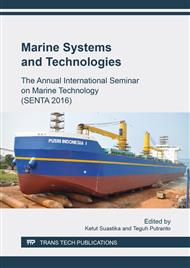p.88
p.96
p.105
p.114
p.121
p.128
p.134
p.140
p.147
Collapse Analysis on VLCC Subjected to Longitudinal Bending with Damages
Abstract:
The objective of the present study is to analyze the progressive collapse of VLCC hull girder with damages subjected to longitudinal bending. For the simple case, the cross-section is assumed to be remained plane and the vertical bending moment is applied to the cross section. The residual stress, initial imperfection, and crack are not considered. The damages scenarios are located at the center part and asymmetric position of the cross section. To analyze the progressive collapse including its behavior of VLCC ship hull, the simply supported is imposed to the cross section and taking the hogging and sagging condition into account. The results obtained for intact and damages condition by the analytical solution is compared and summarized with one another.
Info:
Periodical:
Pages:
121-127
Citation:
Online since:
January 2018
Keywords:
Price:
Сopyright:
© 2018 Trans Tech Publications Ltd. All Rights Reserved
Share:
Citation:


